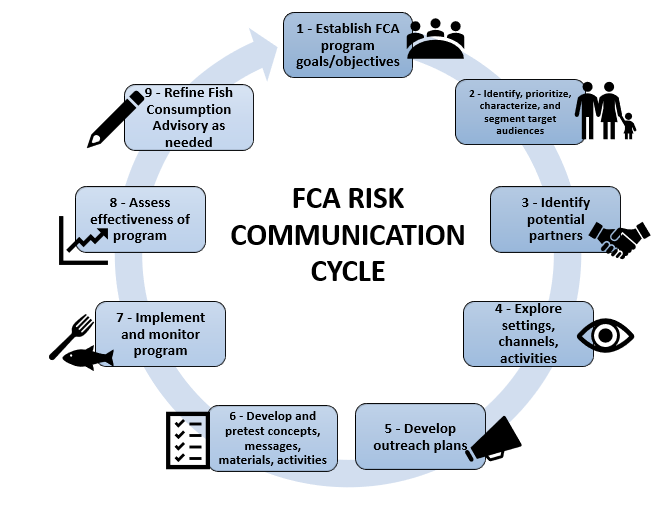3 - Identify Potential Partners
The third step for developing and implementing a risk communication program for fish and shellfish consumption advisories (FCAs) is to identify potential partners to help develop, implement, and communicate FCAs.
Why Partnerships are Important
Partnerships are critical to a successful fish consumption advisory (FCA) communication effort. Using partners allows agencies to leverage resources they do not have and provides a potentially easier way to reach target audiences, especially in the cases of certain communities, e.g., non-English speakers, tribes, ethnic groups who communicate more through verbal means than written means. It is acceptable to partner with more than one organization.
Communities and tribes can articulate their own needs and concerns better than an outsider. By working with partners who are associated with or closely in touch with target audiences, these affected groups will help ensure that the content and medium of advisories are appropriate to their membership. Additionally, both partners and members of target audiences have knowledge indispensable to the evaluation process.
-
Access to a target audience
-
More credibility to the FCA’s message or program, because the target audiences consider the potential partner to be a trusted source
-
An increase in the number of messages the FCA will be able to share with target audiences
-
Additional resources, either tangible or intangible (e.g., volunteers)
-
Added expertise (e.g., language, literacy, cultural knowledge)
-
Expanded support for the FCA’s activities
-
Co-sponsorship of events and activities
Partners can assist with the communication strategy, design of communication materials, and ultimately the implementation of that strategy.
Even if the agency issuing the FCA cannot itself effectively reach the entire target audience, it can provide information in a form that other organizations can use to disseminate and sometimes simply amplify important FCA information.
Considerations
It is worth the time investment to be able to reach target audiences that would otherwise not be reachable due to language differences, for example, especially in the case of non-English speaking target audiences or tribes. It can be time consuming to identify potential partner(s), persuade them to work with the agency issuing the FCA, gain internal approvals, and coordinate planning and other activities. When deciding which partners to work with, consider which:
- Would best reach the target audiences
- Might have the greatest influence and credibility with the target audiences
- Will be easiest to persuade to work with the agency developing the FCA
- Would require less support (e.g., fewer resources) from the agency issuing the FCA
Develop Partnering Plans
Partners can play different roles in communicating FCAs. This list of best practices may be useful to help determine possible roles for partners:
- Choose organizations, agencies, or individuals that can bring the resources, expertise, or credibility to the FCA program.
- Consider which roles partners might play to best support the program.
- Consider having partners:
- Provide supplemental printing, promotion, and distribution of materials
- Sponsor publicity and promotion
- Purchase of advertising space/time, if applicable
- Involve representatives of the organizations as early as appropriate in FCA program planning.
- Give partners the FCA materials' rationale and messages in ready-to-use-form.
- Give partners advance notice so that they can build their part of the program into their schedule and negotiate what will be expected of them.
- Ask partners what they need to implement their part of the FCA. Beyond funding, consider other assistance, training, information, or tools that would enable them to function successfully.
- Provide partners with new contacts or linkages that they will perceive as valuable for their ongoing activities.
- Give partners an appropriate amount of work. Give them a series of small, tangible, short-term responsibilities, as well as a feedback mechanism.
- Remind partners that the agency is relying on them to complete the activities for which they are responsible; help them complete tasks, but do not complete tasks for them.
- Assess progress through the feedback mechanism and help make adjustments to respond to the organization’s needs and to keep the FCA program on track.
- Give partners a final report of what was accomplished and meet to discuss follow-up activities and resources they might find useful. Make sure they feel they are a part of the success of the FCA program.
Potential Partners
You may need a PDF reader to view some of the files on this page. Refer to EPA’s About PDF page to learn more.
-
Fish Consumption and Environmental Justice (2002) (PDF) (185 pp, 2 MB)

